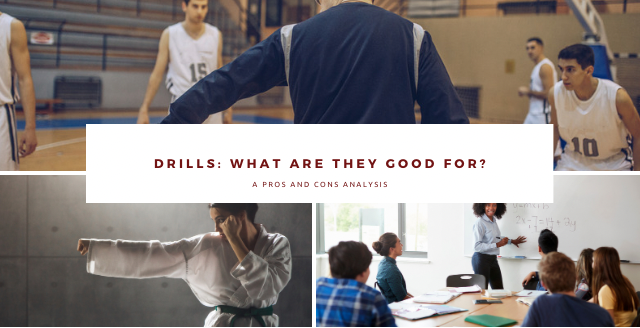Drills: What Are They Good For?

Have you ever practiced the same technique repeatedly, hoping to improve? We call this drilling and in today’s post we are going to talk about the advantages and disadvantages of using drilling as a training method.
What is Drilling?
Drilling is a practice in which the learner repeats a particular task to the point of over learning. It has both physical and mental application; i.e., it’s used to train conceptual understanding and application skills. If used for conceptual learning, this method is essentially rote learning; you keep repeating the information until you learn it “by heart”. Such a method of learning is a lower order learning method and cannot help you master a subject. But it could be a useful technique in learning the fundamentals of any subject. This is one of the learning methods that naturally come to people and is commonly used. A teacher may use a particular version of drilling called chorus drilling, in which she may encourage students to repeat after her. This form of teaching is very efficient for teaching students correct pronunciations (source).
In a sports context, drilling encourages muscle memory. The purpose of drilling in sport is to help the athlete reach a level where the act becomes automated; i.e., the athlete will perform the action without conscious thought. Once again, this is an efficient practice to learn the fundamentals in any sport. Also, when the athlete is lacking in performance in a particular area, it is beneficial for the athlete to drill in that area until they perform better(source).
The Science Behind Drilling
We can categorise knowledge as of 3 types, as seen in the below infographic:

In these 3 types, drilling is useful to develop declarative knowledge and procedural knowledge. Since most people would be familiar with developing declarative knowledge through rote learning, we will focus more on the procedural knowledge part while still talking a bit about the effect of drilling on declarative knowledge.
As mentioned on the infographic, procedural knowledge is knowledge that is demonstrated. It is the application of theory into practice. The highest stage of procedural knowledge is automation when an expert can “proceduralize” a particular task automatically, putting no burden on the working memory. We can apply such automated skills with no conscious thought. For example, consider yourself changing the gear of your car while driving. When you learn how to drive, you have to consciously think about shifting the gear, but this process gradually becomes automated and you learn to shift the gear without consciously thinking about it. That said, not all procedures can be automated, even if you are an expert in the field. For example, you have to watch the traffic while driving regardless of how experienced you are. The situation require you to think strategically and require a separate thinking based on the specific situation. The variation in possible situations makes it impossible for your actions in such situations to be automated. Drilling is a useful practice to reach the level of automation, but it cannot help you achieve the strategic thinking required for the specific game (source).
Then let’s talk about how drilling can help develop procedural knowledge. The development of procedural knowledge occurs in three stages called cognitive, associative, and autonomous stage.
The 3 Stages of Procedural Knowledge
- First stage is the cognitive stage. Cognitive stage is the stage where you have to think about each step of the procedure. In this stage you rely on declarative knowledge and general problem-solving strategy to get the work done. For example, if you have a manual, this is the stage in which you look at each step of the manual before doing a particular task.
- Next is the associative stage, where one step flows into the other. In this stage 2 or more individual steps are combined and can be performed more smoothly. While there is a combination of few steps, not all steps are automated and you will still have to look at the manual to identify the next set of steps.
- The associative stage leads to the autonomous stage where the entire process can be completed in one smooth flow with little attention being paid to the procedure. This is the stage in which you reach automation of the procedure and it can be performed without conscious thought.
This three stage idea is true for the development of basic cognitive skills in any area (source). But to reach the level of automation it requires many hours of practice. Drilling does exactly that by doing one particular task again and again until you reach the level of automation. Drilling is like sticking with a particular task, stubbornly, until you reach automation.
That explains how drilling works in thoery, but we still need to see how it works in practice. Is it more efficient than other methods? How long will what do you learn from drilling last in your brain?
Effect of Drilling on Conceptual Learning
Regarding conceptual learning, several studies have found that flashcards would be a better alternative to drilling. Use of flashcards require you to actively retrieve information, which means it is more likely to stay in your memory for a long period as opposed to drilling where you can keep repeating a concept without actively thinking about it (source). However, drilling can still be useful for short term learning of simple concepts, especially considering how time consuming it can be to make flash cards.
Effect of Drilling on Procedural Knowledge

As for the benefits associated with development of procedural knowledge, an experiment conducted on US Army soldiers founder that over learning through continuous drilling can be as effective as spaced repetition. The experiment tested the ability of the soldiers to re-assemble a machine gun. In the experiment, they divided soldiers into three groups. First group composed of the control group who only practised until they could deliver one error free performance. Second group was the over learning group who did the assembling task until they could perform the task with no error, and then they continued to practice it even after the point. The third was the refresher group who practised beyond the point of zero error and had a refresher course four weeks later where they once again perform the task beyond the point of zero error. They were all tested after 8 weeks from the initial test and the conclusion of the experiment found that both the over learning group and the refresher group performed equally well. Having a refresher course in between made no difference. Both the over learning group and the refresher group performed much better than the control group (source).
So, at least regarding physical performance, over learning can be as efficient as spaced practice and is a much better option than practising till you get something right just once. In other words, it is better to drill a particular task rather than to split up the training into regular intervals. This can save time for other activities while having the same efficiency as spaced practice. In the above study, the effect of drilling stayed with a soldier’s for 8 weeks, even though they did not have any practice during that time.
The next time when your basketball coach ask you to do 100 free throws or when you’re boxing coach asks you to do 100 jabs, remember that it could be a long-term investment, the result for which will stay with you for a long time. The effect of the drilling may eventually fade, then you may be required to re-do the drill to keep the skill, but this fading will take some time if you do mass drilling, like we saw in the above study. That said, now that we consider the benefits of drilling, it’s only fair that we also consider the disadvantages of drilling.
Disadvantages of Drilling
While drilling is very useful to learn basic skills, but it has its own disadvantages.
Firstly drilling is effective when learning basic concepts, but it is not effective when learning more abstract and complex concepts. So this method can be useful when learning elementary level knowledge but not when learning intermediate or upper intermediate level knowledge. Additionally, there is the fact that drilling only helps with memorisation and learning is not all about memorisation. Drilling cannot help you understand what you are reading or repeating. Therefore, while it may be an ideal method for starters, it is one of the least efficient methods for conceptual learning once you move past the basics (source).
Secondly, when using drilling for sports, you need to know whether the particular drill develops skill or fitness. As research proves, it can do either, but not both. Research has found that in volleyball players, skill-based training improves spiking, setting, and passing accuracy and spiking and passing technique, but has little effect on the physiological and anthropometric characteristics of players. So, drilling a particular technique may develop that technique and help you reach automation, but it will not help develop your body to match the requirements of that field. If you play a sport that requires a lot of endurance or strength, this will have to be trained separately (source).
Another problem is with the traditional approach to drilling. The typical method of drilling is for a coach to provide instructions and correction while the drill is being performed, but they provide little instructions during the game. In this approach, they do the drill at the expense of teaching and practising decision-making during the game. The resulting drills require no thinking and as a result is not very relevant to the game. The problem here is that the coach simply tells the player what to do instead of setting up a situation where the player can think for himself using the basic concept and skills that are previously taught. Therefore, drilling is effective when teaching the basic skills. But when it comes to helping a player develop game sense, it’s better to put them in a position where they have to think for them self to solve their problems and find their own method to win the game. As we previously discussed, most sports require strategic thinking, which can never be automated. You can train a person to perform specific techniques until they reach the level of automation, but this does not substitute for separate training for strategic thinking (source).
Let’s conclude with some of the key takeaways:

If you wish to know more about self-regulatory knowledge and how it can be applied to improve your learning strategy, read this post
Related Posts
Reading for Comprehension
Have you ever gone through a difficult reading and realised that you grasped nothing? I…
January 13, 2022Case Study Learning : Ditch the Textbook
In our quest to look for more and more efficient study strategies, today’s…
June 7, 2021


Leave A Comment